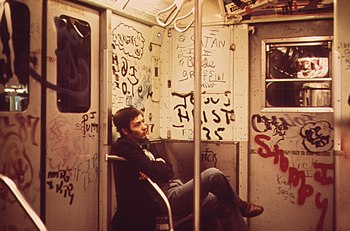
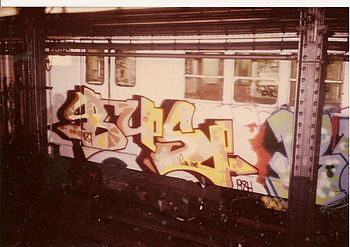
Graffiti in New York City has had a substantial local, national, and international influence.


Graffiti in New York City has had a substantial local, national, and international influence.
Graffiti began appearing around New York City with the words "Bird Lives" [1] but after that, it took about a decade and a half for graffiti to become noticeable in NYC. So, around 1970 or 1971, TAKI 183 and Tracy 168 started to gain notoriety for their frequent vandalism. [2] Using a naming convention in which they would add their street number to their nickname, they "bombed" a train with their work, letting the subway take it throughout the city. [2] [3] Bubble lettering was popular among perpetrators from the Bronx, but was replaced with a new "wildstyle", a term coined by Tracy 168 and a legendary original Graffiti crew with over 500 members including Blade, Cope 2, T Kid 170, Cap, Juice 177, and Dan Plasma. [4] [5] Graffiti tags started to grow in style and size. [3] Notable names from that time include DONDI, Lady Pink, Zephyr, Julio 204, Stay High 149, PHASE 2. [3] [4]
Graffiti was growing competitive and artists desired to see their names across the city. [3] Around 1974 suspects like Tracy 168, CLIFF 159 and BLADE ONE started to create works with more than just their names: they added illustrations, full of scenery and cartoon characters, to their tags, laying the groundwork for the mural-car. [3] The standards from the early 1970s continue to evolve, and the late 1970s and early 1980s saw new styles and ideas. As graffiti spread beyond Washington Heights and the Bronx, a graffiti crime wave was born. Fab 5 Freddy (Friendly Freddie, Fred Brathwaite) was one of the most notorious graffiti figures of that era. He notes how differences in spray technique and letters between Upper Manhattan and Brooklyn began to merge in the late 1970s: "out of that came 'Wild Style'." [6] Fab 5 Freddy is often credited with helping to spread the influence of graffiti and rap music beyond its early foundations in the Bronx, and making links in the mostly white downtown art and music scenes. It was around this time that the established art world started becoming receptive to the graffiti culture for the first time since Hugo Martinez's Razor Gallery in the early 1970s.
The growth of graffiti in New York City was enabled by its subway system, whose accessibility and interconnectedness emboldened the movement, who now often operated through coordinated efforts. [3] [7] It was further left unchecked due to the budgetary restraints on New York City, which limited its ability to remove graffiti and perform transit maintenance. [3] Mayor John Lindsay declared the first war on graffiti in 1972, but it would be a while before the city was able and willing to dedicate enough resources to that problem to start impacting the growing subculture. [2] [3]
The Abraham Beame Administration established a police squad of about 10 police officers to work in anti graffiti capacity. The squad attended informal meetings and socialized with minor suspects to gather information to help them apprehend leaders. Although the squad gathered information on thousands of graffiti vandals, inadequate manpower prevented them from following through with arrests. [8]
Graffiti vandal arrests in New York City were reported at around 4,500 between 1972 and 1974, 998 in 1976, 578 in 1977, 272 in 1978, 205 in 1979. [8]
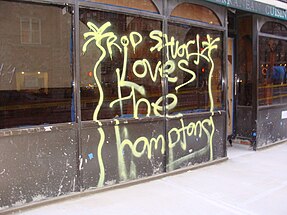
As graffiti became associated with crime, many demanded that the government take a more serious stance towards it, particularly after the popularization of broken windows theory. [2] [9] [10] By the 1980s, increased police surveillance and implementation of increased security measures (razor wire, guard dogs) combined with continuous efforts to clean it up led to the weakening of New York's graffiti subculture. [7] As a result of subways being harder to paint, more writers went into the streets, which is now, along with commuter trains and box cars, the most prevalent form of writing. But the streets became more dangerous due to the burgeoning crack epidemic, legislation was underway to make penalties for graffiti artists more severe, and restrictions on paint sale and display made obtaining materials difficult. [3]
Many graffiti artists, however, chose to see the new problems as a challenge rather than a reason to quit. [3] A downside to these challenges was that the artists became very territorial of good writing spots, and strength and unity in numbers (gangs) became increasingly important. [3] This was stated to be the end for the casual subway graffiti artists.
In 1984, the New York City Transit Authority (NYCTA) began a five-year program to eradicate graffiti. The years between 1985 and 1989 became known as the "diehard" era. [3] A last shot for the graffiti artists of this time was in the form of subway cars destined for the scrap yard. [3] With the increased security, the culture had taken a step back. The previous elaborate "burners" on the outside of cars were now marred with simplistic marker tags which often soaked through the paint.
By mid-1986, the Metropolitan Transportation Authority (MTA) and the NYCTA were winning their "war on graffiti", with the last graffitied train removed from service in 1989. [2] [3] [11] As the population of artists lowered so did the violence associated with graffiti crews and "bombing". [3] However, teenagers from inner London and other European cities with family and other links to New York City had by this time taken up some of the traditions of subway Graffiti and exported them home, although New York City writers like Brim, Bio, and Futura had themselves played a significant role in establishing such links when they visited London in the early-to-mid-1980s and "put up pieces" on or near the western ends of the Metropolitan line, outside London.
Almost as significantly, just when subway graffiti was on the decline in New York City, some British teenagers who had spent time with family in Queens and the Bronx returned to London with a "mission" to Americanize the London Underground Limited (LUL) through painting New York City-style graffiti on trains. These small groups of London "train writers" (LUL writers) adopted many of the styles and lifestyles of their New York City forebears, painting graffiti train pieces and in general "bombing" the system, but favoring only a few selected underground lines seen as most suitable for train graffiti. Although on a substantially smaller scale than what had existed in New York City, graffiti on LUL rolling stock became seen as enough of a problem by the mid-1980s to provoke the British Transport Police to establish its own graffiti squad modeled directly on and in consultation with that of the MTA. At the same time, graffiti art on LUL trains generated some interest in the media and arts, leading to several art galleries putting on exhibitions of some of the art work (on canvass) of a few LUL writers as well as TV documentaries on London hip-hop culture like the BBC's Bad Meaning Good, which included a section featuring interviews with LUL writers and a few examples of their pieces.

The Clean Train Movement, wherein the rolling stock was either cleaned or outright replaced, started in 1985, with the last graffiti-covered train out of service by 1989. [2] [3] [11] With subway trains being increasingly inaccessible, other property became the targets of graffiti. Rooftops became the new billboards for some 1980s-era writers. [11] The current era in graffiti is characterized by a majority of graffiti artists moving from subway or train cars to "street galleries".[ citation needed ] Prior to the Clean Train Movement, the streets were largely left untouched not only in New York City, but in other major American cities as well.[ citation needed ] After the transit company began diligently cleaning their trains, graffiti burst onto the streets of America to an unexpecting and unappreciative public.[ citation needed ]
City officials elsewhere in the country smugly assumed that gang graffiti were a blight limited largely to the Big Apple [New York City]. The stylized smears born in the South Bronx have spread across the country, covering buildings, bridges and highways in every urban center. From Philadelphia to Santa Barbara, Calif., the annual costs of cleaning up after the underground artists are soaring into the billions. [12]
Meanwhile, in New York in 1995, Mayor Rudolph Giuliani set up the Anti-Graffiti Task Force, [13] a multi-agency initiative to combat graffiti in New York City. This began a crackdown on "quality-of-life crimes" throughout the city, and one of the largest anti-graffiti campaigns in U.S. history. That same year Title 10-117 of the New York Administrative Code banned the sale of aerosol spray-paint cans to children under 18. The law also requires that merchants who sell spray paint must either lock it in a case or display the cans behind a counter, out of reach of potential shoplifters. Violations of the city's anti-graffiti law carry fines of US$350 per incident. [14]
On January 1, 2006, in New York City, legislation created by Councilmember Peter Vallone, Jr. attempted to raise the minimum age for possession of spray paint or permanent markers from 18 to 21. The law prompted outrage by fashion and media mogul Marc Ecko who sued Mayor Michael Bloomberg and Councilmember Vallone on behalf of art students and "legitimate" graffiti artists. On May 1, 2006, Judge George B. Daniels granted the plaintiffs' request for a preliminary injunction against the recent amendments to the anti-graffiti legislation, effectively prohibiting the New York Police Department from enforcing the higher minimum age. [15] A similar measure was proposed in New Castle County, Delaware in April 2006 [16] and passed into law as a county ordinance in May 2006. [17]
At the same time, graffiti has begun to enter mainstream. [2] Much controversy arose on whether graffiti should be considered an actual form of art. [2] [3] [18] [19] In 1974, Norman Mailer published an essay, The Faith of Graffiti , that explores the question of graffiti as art and includes interviews from early subway train graffitists, and then New York City mayor, John Lindsey. Since the 1980s, museums and art galleries started treating graffiti seriously. [2] Many graffiti artists had taken to displaying their works in galleries and owning their own studios. This practice started in the early 1980s with artists such as Jean-Michel Basquiat, who started out tagging locations with his signature SAMO ("Same Old Shit"), and Keith Haring, who was also able to take his art into studio spaces. In some cases, graffiti artists had achieved such elaborate graffiti (especially those done in memory of a deceased person) on storefront gates that shopkeepers have hesitated to cover them up. In the Bronx after the death of rapper Big Pun, several murals dedicated to his life done by Bio, Nicer TATS CRU appeared virtually overnight; [20] similar outpourings occurred after the deaths of The Notorious B.I.G., Tupac Shakur, Big L, and Jam Master Jay. [21] [22]

Graffiti is art that is written, painted or drawn on a wall or other surface, usually without permission and within public view. Graffiti ranges from simple written words to elaborate wall paintings, and has existed since ancient times, with examples dating back to ancient Egypt, ancient Greece, and the Roman Empire.

Beat Street is a 1984 American dance drama film featuring New York City hip hop culture of the early 1980s. Set in the South Bronx, the film follows the lives of a pair of brothers and their group of friends, all of whom are devoted to various elements of early hip hop culture, including breakdancing, DJing and graffiti.

Leonard Hilton McGurr, known as Futura, and formerly known as Futura 2000, is an American graffiti artist.
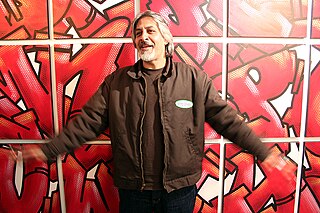
Richard "Richie" Mirando, known as Seen UA is an American graffiti artist. He is one of the best known graffiti artists in the world and has been referred to as the Godfather of Graffiti.

Michael "Iz the Wiz" Martin was one of the most prominent graffiti writers of the New York graffiti movement of the late 1970s and early 1980s.
George Lee Quiñones is a Puerto Rican artist and actor. Quiñones rose to prominence by creating massive New York City subway car graffiti that carried his moniker "LEE". His style is rooted in popular culture and often with political messages.

Lady Pink, born Sandra Fabara (1964), is an Ecuadorian-American graffiti and mural artist.

Fernando Carlo is an artist from the Kingsbridge section of the Bronx, New York.

A number of words and phrases that have come to describe different styles and aspects of graffiti and its subculture. Like other jargon and colloquialisms, some of these terms may vary regionally, taking on different meanings across different cities and countries. The following terminology originates primarily in the United States.

Crash is a graffiti artist.
PRIZ-ONE is the graffiti tag of a Cuban-American commercial artist, illustrator, and ex-golden glove boxer.

Tats Cru, Inc. is a group of Bronx-based graffiti artists turned professional muralists. The current members of Tats Cru are Bio, BG183,FEVER, Nicer, HOW, and NOSM. Tats Cru were founded by Brim, Bio, BG183 and Nicer.
RISK, also known as RISKY, is a Los Angeles–based graffiti writer and contemporary artist often credited as a founder of the West Coast graffiti scene. In the 1980s, he was one of the first graffiti writers in Southern California to paint freight trains, and he pioneered writing on "heavens", or freeway overpasses. He took his graffiti into the gallery with the launch of the Third Rail series of art shows, and later created a line of graffiti-inspired clothing. In 2017, RISK was knighted by the Medici Family.
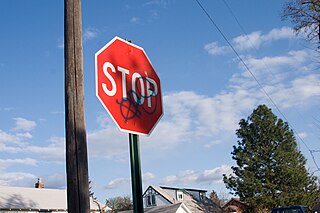
Graffiti are writing or drawings scribbled, scratched, or sprayed illicitly on a wall or other surface in a public place. Graffiti ranges from simple written words to elaborate wall paintings. Graffiti, consisting of the defacement of public spaces and buildings, remains a nuisance issue for cities.

Commercial graffiti is the commercial practice of graffiti artists being paid for their work. In New York City in particular, commercial graffiti is big business and since the 1980s has manifested itself in many of the major cities of Europe such as London, Paris and Berlin. Increasingly it has been used to promote video games and even feature prominently within them, reflecting a real life struggle between street artists and the law. Commercial graffiti has created significant controversy between those who view it as an effective medium of advertising amongst specific target audiences and those who believe that legal graffiti and advertising using it encourages illegal graffiti and crime.

Darren Cullen is a London-based professional graffiti artist who is commonly known by the tag name SER. Cullen emerged as an artist from the British graffiti art scene in the early 1980s.

Jack Stewart was an American artist. Born in Atlanta, Georgia, he began private art lessons when he was seven. When he was about nine he went to classes at the High Museum of Art. In his early to mid-teens he apprenticed to the sculptor/painter Steffen Thomas. During WWII he served in Patton's Third Army as a combat infantryman, entering combat in the Battle of the Bulge. After the war he earned a BFA degree at Yale University, where he studied with Josef Albers and Willem de Kooning. He studied architecture at Columbia University and later earned MA and Ph.D. degrees at New York University. In 1976 Stewart married painter and art administrator Regina Serniak Stewart. His first wife and their son are deceased.

MadC is a graffiti writer and muralist. She was born in Bautzen, Germany, and is most known for her large-scale, outdoor artistic paintings.
Torrick Ablack, also known as Toxic, is an American artist who was part of the graffiti movement of the early 1980s in New York City. He transitioned from street art to exhibiting his paintings in galleries and museums internationally.
Notes
Further reading